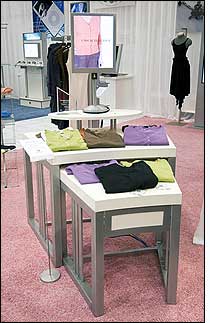Canadian retailer Nygard International is piloting an RFID-enabled system in its Toronto store that displays product information on a video screen. The SmartTable, provided by digital signage maker GFX Dynamics, allows the store to provide details about an item of clothing as shoppers pick it up for a closer look. The store installed the system in the fall of 2005.
“The goal of this pilot is to refine the technology prior to rollout,” says Alan Brask, GFX Dynamics’ vice president and general manager. The end of the pilot period has yet to be determined.
With the SmartTable, the store can present details such as the size, price or design of the product, as well as suggest accessories or other clothing items to accompany it. Nygard is currently using only one SmartTable and screen in a fashion department at the front of its store.
The Nygard SmartTable consists of a table holding a ThingMagic Mercury3 reader and a computer, another table with merchandise and, above that, an LCD screen displaying product information. Nygard employees attach 13.56 MHz RFID tags compliant with the ISO 15693 standard to the merchandise being tracked in the pilot.
The tags’ ID numbers are mapped to particular stock-keeping units (SKUs) and held in the system’s database. Tags are assigned a category such as blouse or pants, and content associated with the tag is changed to match the merchandise currently on display. The RFID tags are removed and reused at the time Nygard merchandise is purchased.
According to Brask, the system is designed to work with other frequencies too. “GFXD has maintained concurrent development paths at the 125 kHz, 13.56 MHz and 915 MHz frequencies, and can easily adapt to a client’s preferences or needs,” he says. When the reader scans data from the merchandise tags, the Windows XP computer interfaces with the reader, handles all database functions and displays content on a 19-inch or 23-inch LCD screen, known as a DupliView. The DupliView screen is viewable by customers standing either directly in front of it, or on either side, and optional speakers can be integrated into its base.
A full implementation of the system—including tags, reader, software, store fixtures, the DupliView LCD display and the computer—costs between $2,000 and $9,000, Brask says, depending on the design and materials used in the fixture, as well as the complexity of the application. “The technology can potentially be integrated into a customer’s existing fixture or display for less—and, of course, higher-volume orders will allow for economies of scale.”
GFX Dynamics designed the Nygard SmartTable in a style that mimics other Nygard fixtures, Brask explains. The SmartTable’s purpose is to provide shoppers with details that can help them make decisions about the products they purchase.
“In previous times, there would have been a knowledgeable sales associate walking you through the store and helping you with the merchandise,” he says. This system is intended to provide that same information to the shopper, specific to the merchandise he or she is looking at. “Customers respond to digital signage if it helps them with information related to the product they are shopping for. We’re triggering content that is relevant to the customer at that moment.”
To determine the success of the system, GFX Dynamics interviewed several Nygard customers. “They respond very positively to the table and Nygard’s use of the technology,” Brask says. “The table gets a lot of use, which has made the biggest challenge assisting Nygard in figuring out an internal process for maintaining the flow of content and merchandise to the table.”
Nygard sells in high volume. Because of this, says Brask, if the store sells out of a particular piece of merchandise very quickly, it must have RFID tags and related content on the RFID networked database associated with those tags prepared for replacement items.



